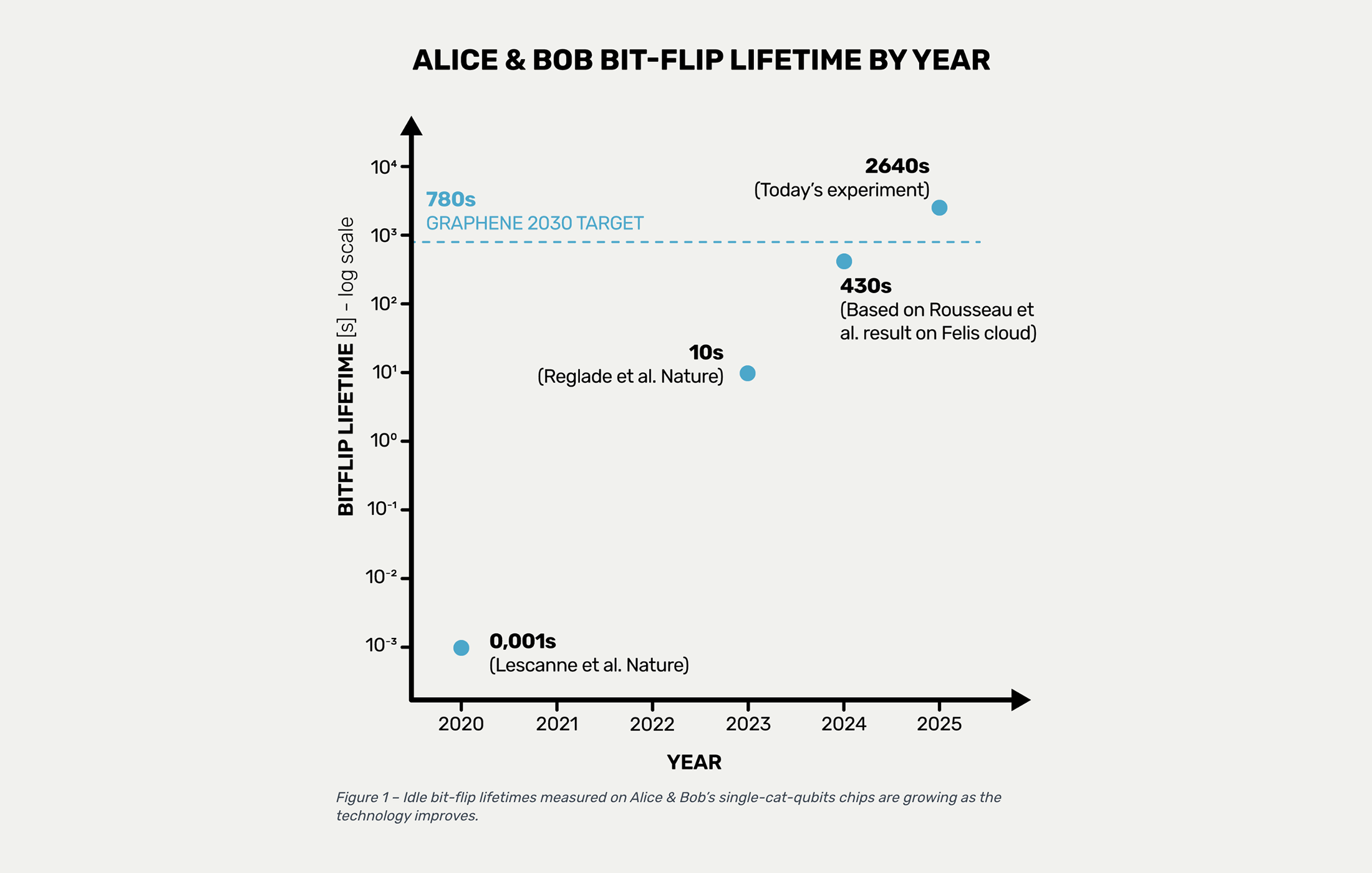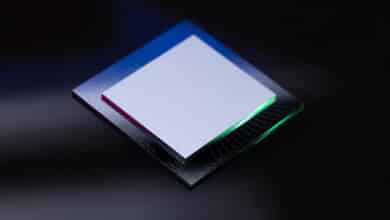Alice & Bob’s One-Hour “Cat Qubit” Breakthrough – What It Means for Quantum Computing and Q-Day

Table of Contents
25 Sep 2025 – A new experiment from quantum computing startup Alice & Bob has set a remarkable milestone. In a recent blog post titled ”Just Out of the Lab: A Cat Qubit That Jumps Every Hour,” the company revealed that one of its qubits – a special ”cat qubit” – remained stable against bit-flip errors for about one hour. This is a record for superconducting qubits, shattering the previous bit-flip stability mark of roughly 7 minutes achieved last year. It even far exceeds Alice & Bob’s own goal of 13 minutes that was planned for a 2030-era device.
In other words, what wasn’t expected until the end of the decade has already been demonstrated in the lab today.
This announcement, also shared via the company’s social media, has generated buzz in the quantum community. But why is a qubit lasting an hour so important, and what does it mean for the broader race toward practical quantum computers?
A Qubit That Only Flips Once an Hour
Alice & Bob’s experiment showed that their cat qubit can go nearly an hour on average before a bit-flip error occurs. To put it simply, a bit-flip error is when a qubit that should represent a ”0” suddenly flips to a ”1” (or vice versa) due to environmental noise or imperfections. In conventional superconducting qubits (like the transmon qubits used by IBM and Google), such flips happen very frequently – typically within a few milliseconds. By contrast, Alice & Bob observed only 41 flips over 61 hours. That’s one flip about every 44 minutes on average, with a 95% confidence interval suggesting the true mean could be between 33 and 60 minutes. This kind of stability is unprecedented for a quantum bit in any superconducting platform.
The term ”cat qubit” comes from Schrödinger’s cat – a quantum thought experiment of a cat in a superposition of being alive and dead. Similarly, Alice & Bob’s cat qubit is a special state of a microwave resonator that exists in a superposition of two opposite conditions (like two versions of the resonator’s oscillation). This design makes the qubit inherently resistant to bit-flips – it ”actively stabilizes” itself, much like how a tightrope walker uses a pole for balance. Bit-flips become extremely rare, though the trade-off is that another type of error (phase flips) can happen a bit more often.
Importantly, Alice & Bob’s qubit still behaves as a true quantum bit despite being so stable. The team confirmed that it can hold a quantum superposition (the hallmark of being a genuine qubit, not just a classical memory) and perform operations at high fidelity. In fact, they demonstrated a basic quantum logic operation (a Z gate) on this qubit with over 94% fidelity, and measured a phase-flip error timescale on the order of 0.4 microseconds. So while the qubit’s ”quantum jumps” (bit-flips) are exceedingly rare, it still can do all the quantum things we need it to do – just with fewer interruptions from errors.
Why This Milestone Matters
To understand the impact, it helps to know that errors are the biggest obstacle in building large, useful quantum computers. Quantum bits are notoriously delicate: they can lose their state or flip values due to the slightest disturbance. Bit-flip errors (0↦1 or 1↦0 flips) and phase-flip errors (the qubit’s phase drifting, messing up superpositions) are the two primary types. In most quantum chips today, both kinds of errors happen often, requiring complex error correction schemes that use many physical qubits to collectively encode a single more-stable logical qubit. For example, the popular ”surface code” approach might need 1000+ physical qubits per logical qubit to handle all these errors. This huge overhead is a major reason we don’t yet have quantum computers that can do very long or complex calculations.
What Alice & Bob demonstrated is essentially a qubit that almost never flips on its own during the timescale of an algorithm. Their cat qubit’s bit-flip rate is millions of times lower than that of a typical superconducting qubit. This means, in principle, you can all but ignore bit-flip errors when running computations on these qubits. You’d only really need to correct the remaining phase-flip errors. Why is that a big deal? Because if the hardware itself isn’t flipping bits, the burden on error correction is drastically reduced. Alice & Bob’s team explains that this could make their quantum computers ”hundreds of times more hardware-efficient,” requiring on the order of tens of physical qubits instead of thousands for each error-corrected qubit. Similarly, an independent summary noted that suppressing bit-flips could cut total qubit requirements by up to 200× for large-scale machines.
In practical terms, this efficiency gain might be the difference between needing a football-stadium-sized quantum computer versus one that fits in a large room. It brings the vision of a fault-tolerant quantum computer (one that corrects its own errors on the fly and can run any long algorithm reliably) much closer to reality. By eliminating one entire category of errors at the hardware level, Alice & Bob can focus on a simpler 1D error-correcting code to fix phase errors. This is a much easier task than the 2D codes needed to tackle both errors at once, and it means every additional qubit they add contributes more directly to computing power rather than being swallowed up by error-correction overhead.
Another reason the one-hour stability result matters is that it exceeded expectations by a wide margin. It’s four times longer than the 13-minute bit-flip lifetime goal Alice & Bob had set for five years from now. Achieving this milestone early suggests that progress in quantum hardware might be accelerating. It’s also intriguing that the observed bit-flip rate is slower than natural background events like cosmic rays hitting the chip. (Cosmic rays are high-energy particles from space that can jostle qubits – they typically strike a given chip more frequently than once per hour. The Alice & Bob qubit, however, went beyond that interval, hinting that it might be somewhat resilient even to those sporadic disturbances.) All of this builds confidence that these cat qubits are not just laboratory curiosities, but robust enough to form the building blocks of larger machines.
Paving the Way to Fault-Tolerant Quantum Computers
Alice & Bob’s broader goal is to build a useful, fault-tolerant quantum computer by the end of the decade. With this new breakthrough, they are well on their way. The company’s roadmap calls for progressively scaling their technology: first creating a single logical qubit out of multiple physical cat qubits (their current”Helium” chip in 2025 is targeting this), then moving to a handful of logical qubits with logical gates between them (“Lithium” series), and eventually a universal quantum processor with ~100 logical qubits by 2030 (the”Graphene” series). That 2030 machine, if achieved, would likely be one of the first error-corrected quantum computers in the world, capable of running stable algorithms far beyond the reach of today’s noisy devices.
Thanks to the cat qubit’s efficiency, those ~100 logical qubits might be built using only a few thousand physical qubits (as opposed to perhaps a hundred thousand or more with other architectures). One report notes that Alice & Bob expect about 15 physical qubits per logical qubit in their near-term design. By comparison, Google’s recent prototype logical qubit needed 49 physical qubits and still wasn’t fully above error-correction threshold. The upshot is that scaling up with cat qubits could happen with far fewer resources than previously thought necessary. In the words of Alice & Bob’s CEO, Théau Peronnin, ”Where conventional approaches would require millions of qubits, we would need only thousands” to reach cryptographically relevant scales. If this holds true, it dramatically shortens the path to building quantum computers that can tackle industry-scale problems.
Of course, there are still challenges ahead. The next big step for Alice & Bob is demonstrating that this hour-long stability holds when multiple qubits interact. Thus far, the record pertains to a single qubit staying in one piece. The company plans to test two-qubit gates (like entangling operations) on the Helium chip next. Two-qubit operations might introduce new avenues for errors, so verifying that the cat qubits retain their advantage in a full circuit will be critical. Additionally, while bit-flips are now exceedingly rare, phase-flip errors remain and need to be corrected by the software/hardware feedback loop. Alice & Bob is working with partners on fast error decoders to catch these phase errors in real time. They’ll need to show that they can string together long sequences of operations on logical qubits without the quantum state falling apart.
If those hurdles are overcome, Alice & Bob’s approach could unlock an early fault-tolerant quantum computer with on the order of 100 logical qubits in the next few years. That scale might be enough for initial applications in areas like materials science or chemistry (for example, simulating molecular structures that are hard for classical computers). It would also be a proof-of-concept that fully error-corrected quantum computing is possible without needing millions of qubits. From there, the company envisions scaling to thousands of logical qubits in the early 2030s. Such a machine would be edging into the regime where truly classically intractable problems – including breaking some forms of encryption – become feasible.
Implications for Q-Day
Q-Day is a term used to mark the day when a quantum computer becomes powerful enough to break public-key cryptography such as RSA and ECC. In other words, it’s when a cryptographically relevant quantum computer (CRQC) comes online – one capable of running Shor’s algorithm on real-world encryption keys within a reasonable time.
The breakthrough by Alice & Bob may accelerate the Q-Day timeline. By greatly reducing the error overhead, their cat qubit approach could mean that a code-breaking quantum computer might need far fewer qubits than we feared.
The takeaway is that Q-Day could arrive sooner than anticipated if these hardware advances continue. Progress in quantum computing is not strictly linear or predictable – it often comes in leaps due to scientific breakthroughs. A milestone like the one-hour cat qubit is exactly the kind of leap that can force us to update our expectations.
Quantum Upside & Quantum Risk - Handled
My company - Applied Quantum - helps governments, enterprises, and investors prepare for both the upside and the risk of quantum technologies. We deliver concise board and investor briefings; demystify quantum computing, sensing, and communications; craft national and corporate strategies to capture advantage; and turn plans into delivery. We help you mitigate the cquantum risk by executing crypto‑inventory, crypto‑agility implementation, PQC migration, and broader defenses against the quantum threat. We run vendor due diligence, proof‑of‑value pilots, standards and policy alignment, workforce training, and procurement support, then oversee implementation across your organization. Contact me if you want help.



